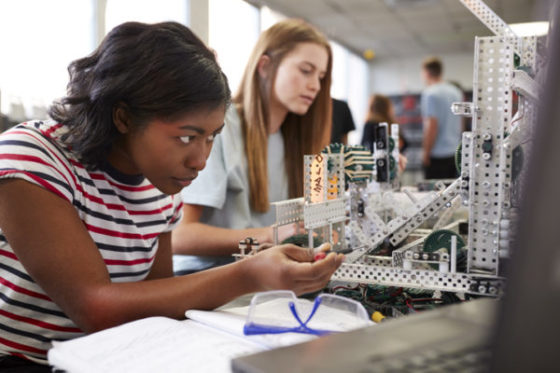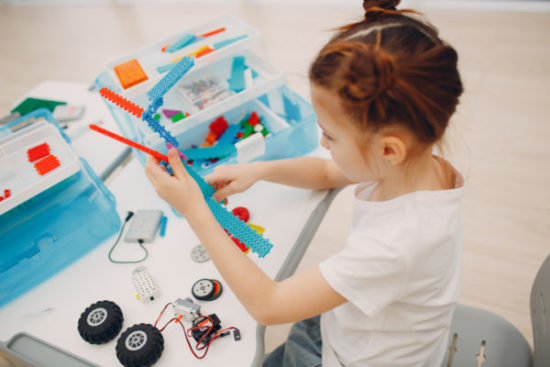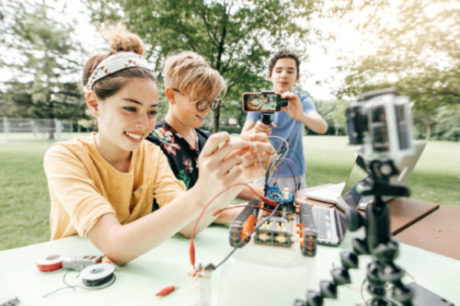Robotics for Kids: How & When to Get Them Involved
You’ve heard that STEM education can boost critical thinking and problem solving skills, and of course, there’s the career development aspect.
You know the way the world is turning – more gamification, IT and coding now taught in early education, and robotics increasingly entering the everyday environment. It’s always better to prepare your children for this sooner, rather than later, right?
But how soon is too soon? When is the best time to introduce robotics for kids. And how do you introduce it without frustration or massive cost?
In this article, we’re laying out how to do just that – covering the why, how, and when of robotics for kids.
Why is it important for kids to learn about robotics?
Robotics puts a lot of engineering disciplines into one system.
In other words, it’s not about focusing on one area of skill that a student might not excel at, but rather, how each fits into the larger picture.
This gets a student involved in complex tasks without relying on one area or another, which may otherwise steer them away from exploring STEM (science, technology, engineering and math) disciplines.
(“What is STEM education?” you might ask. Check out our blog blog post: What Is STEM Education & Why Is It Important?)
And, because a robot is a full system, it requires a bit of teamwork and communication. So robotics automatically builds life and work skills into the task.
Ultimately, it’ll help a child build an identity as a creator, collaborator, communicator, and/ or change-maker.
But that’s not where the importance of robotics ends.
Improving education scores with robotics
Back in 2005, the Nebraska State 4-H teamed with a rural elementary school’s after school care program to test whether or not using robotics kits and implementing robotics in education, impacts test scores and comprehension levels.
Naturally, they used a control group in addition to the robotics group, did a pre and post test, and so on to conduct a legitimate study of the effects of robotics education.
Sure enough, the robotics group tested far better in their post-test than the control group.
The simple act of allowing students to work with science kits and workbook material can drastically improve other skills and knowledge areas.
Beyond the reality that robotics education improves most areas of comprehension, there’s a general shift in education toward robotics and gamification that we need to keep up with.
Adjusting to the general shift in education
The educational robot market is likely to jump to $2.6 billion by the year 2026, growing from $1.3 billion in 2021– according to a report from MarketsandMarkets.
Why, though?
While just 30 years ago, 5th graders were learning how to type on a keyboard, today learners of that age are taking coding and programming language classes.
It’s essential that they do, too, in order to keep up with career and market trends. After all, the goal of school is to prepare them for the real world and for the job market (the industrial robotics industry is projected to grow by more than 10% over the next 4 years alone).
If we’re strictly talking about careers in the robotics industry (as opposed to all other industries in which robotics education can be really instrumental), these are rising positions:
- Design engineer
- Software engineer
- User experience designer (UX designer)
- Data scientist
- Hardware engineer
- Algorithm engineer
- Machine learning engineer
It isn’t just that there are more technical careers and robotics in our future, but that the shape of learning is different now.
If you’d have told anyone a couple decades ago (maybe even just one decade ago), that gamification is an education tool, no one would believe you.
Today, schools and teachers are using gamification to help teach complex topics – math, coding, programming – in a way that young minds can easily grasp (and that easily holds their attention).
The introduction of robotics is just another layer of that.
How do I determine if my child should take robotics classes?
As more and more classrooms involve robotics education, it’s likely they’ll encounter it at some point. However, it’s not always accessible for every school or student.
If your child is interested in robotics, but it’s not accessible through their school, you could consider external robotics classes or even robotics kits for at-home lessons.
iRobot offers teachers and parents access to a wide array of free resources
Some schools and cities also offer robotics teams or clubs. Get some information from these programs, speak to your child, and gauge their interest to determine if they should start on any type of robotics program.
What age should a child start robotics education?

Or maybe it’s better to think about robotics education as a method for learning every other skill needed as a successful adult: communication skills, teamwork, and creativity. Whether your child pursues a career in marketing, web design, graphics, law, or accounting, these skills are invaluable.
We also can’t forget the ability to see how all things connect for a single result.
No matter how you think of it, the earlier they begin to learn robotics, the better.
If you really want to put a number on it though, education researchers in Australia determined that children as young as 4 can learn the basics of robotics. They’ve discovered that children, even at that age, can easily understand how different robots receive their commands.
In the study, they witnessed these students drawing pictures of their robot and have captured them explaining how they were able to control the robot’s behavior through coded messages.
What’s even more interesting is, even if the student doesn’t fully grasp the concepts while learning robotics, their skills in problem solving – and various other life skills – still improve.
They’re encouraged to fail (we believe this is a good thing!). They’re encouraged to make mistakes, make disastrous robots, and to discover new things about their robots on their own. Doing so means they’re more likely to take leaps with learning (and in life) in the future because the fear of failure isn’t holding them back.
If anything, the sooner you get them started, the less intimidating science, math, and technology will feel to them throughout their lives.
How do I start my child in robotics? (a roadmap for robotics education)
Humans are innately curious. We’re natural scientists, creators, and builders, so it often doesn’t take much to get young children interested in robotics.
You can even check out our blog, How to Make a Robot and see if this already peaks your child’s interest.
For beginners, these complex skills and tasks can be broken down, gamified, and made digestible. You might simply start by having them imagine what a robot could do for them, and give them the tools to draw it out.
Taking apart a robot, watching videos and reading about robots, or playing robot games online are all easy introductions to robotics.
Watch this video to see iRobot’s CEO take a part a robot.
iRobot CEO takes apart a Roomba for National Robotics Week
iRobot CEO Colin Angle believes that one of the best ways to learn how something works is by taking it apart. In honor of National Robotics Week, Mr. Angle dismantles a Roomba robot vacuum to demonstrate that its not “magic” that makes a Roomba tick, but great engineering.That said, we’ve put together a little roadmap that details the kinds of things they can learn at each stage of their robotics education and how you may go about teaching them.
Robotics education for beginners
In this stage, it’s more about getting your child excited about robotics. There really are quite a few ways to do this, a few we’ve already mentioned – online games, shows (hello, Jetson’s), YouTube videos, and chapter books with robot characters. This provides an opportunity to discuss what a robot actually is and what it does.
At iRobot, we like to say that a robot is a tool that can help us with dull, dirty or dangerous tasks.
Something as simple as getting them to imagine a robot and draw up their dream creation can put them on the path to STEM.
Additionally, helping young engineers understand that they’re already applying robotic concepts in their everyday lives, such as following a recipe or playing follow-the-leader can help them connect with their STEM identities.
But there are a few other simple things you can do, either as a parent or an educator, to get kids excited to learn about robotics.
Here are a few for age groups 4-6:
- Find online challenges you can work on together
- Watch movies and shows about robots (Big Hero 6, Next Gen, Wall-E, and The Iron Giant)
- Find robotics clubs and workshops at your local library
- Visit a robotics museum (like the Tech Museum of Innovations)
- Join online communities with discussions and games for young students
- Try a few arts and crafts projects that lean toward robotics (like a battery powered cardboard animal)
For kids ages 6-8 (depending on their proficiency):
Most comprehensive robotics education programs start with learning basic assembly skills, electronics, circuitry, and even coding.
It may seem like 8 years old is too early for something like coding, but some schools across the United States hold coding classes for children in that age range. Some online coding courses were designed for kids as as young as age 5.
Some of the best ways to start kids of this age in robotics is by:
- Joining a robotics social club
- Signing them up for a robotics summer camp or after school program (there are a some online an in-person coding camps)
- Letting them play educational games (like Snow Day Adventure)
- Using coding apps (like our iRobot coding app)
- Use the iRobot® Root Coding Robot
- Doing simple electronic activities such as making a simple traffic signal, or lighting up an LED
- Having them do arts and crafts projects that involve building (there are plenty of simple robot building activities online and in our iRobot® Learning Library)
- Use the iRobot® coding simulator
Robotics for kids 8-12:
While kids in this age range tend to still be beginners, they’re likely to have a few more skills to tap into if they’ve been involved and engaged with robotics education before.
Even if they haven’t, the activities and ideas below are still great ways to get them started:
- Get a robotics kit that interests them
- Sign them up for a virtual or in-person tech camp (or STEM camp)
- Purchase books on robotics for beginners that’ll teach them the basics step by step
- Enroll them in a robotics course
- Have them deconstruct a robot, or some other technology, and put it back together again
Intermediate and advanced robotics education
As students advance, they’re going to face some more challenging aspects of robotics, such as object-oriented programming, physics and probability, and embedded systems.
If they continue to pursue any type of robotics career, they’ll need to familiarize themselves with the Robot Operating System (ROS), 3D design software, machine learning libraries, operating systems (like Linux), and much more.
The best way to learn any of this is through:
- Courses
- Robotics and STEM camps
- Robotics competitions (FIRST family, BotBall, Vex, etc.)
- Joining robotics groups and teams
- Putting together robotics kits, or building your own robot from scratch
Of course, the greater the foundation, the easier it is to learn these advanced topics. Depending on the age, gamification can also be a great way to learn these complex skills and lessons without strain.
When a student reaches advanced robotics topics, they can progress beyond school learning and experiences to grow even further.
Many robotics competitions, like FIRST and Vex are great ways to gain that experience.
The foundation of skills they’ve developed through this learning can propel them into other STEM fields, or simply strengthen their learning and development through the rest of their lives.
Robotics classes for kids
One of our favorite places to recommend for in-person STEM learning (with wonderful hands-on projects) is The Clubhouse Network.
It’s a global community with over 100 clubhouses across 21 countries. They serve roughly 25,000 young students each year, not just in robotics, coding, and STEM, but in music technology and art as well.
While there are 100 clubhouses in their network, it’s fairly spread out across the globe. If there isn’t one near you, search for classes that truly let children go through the build process of robotics. This is where much of the value lays.

- Check with your local library
- Ask your child’s school
- Ask your local university about summer camps and programs for younger students
- Search the internet for local after-school programs (many cities have dedicated STEM programs for after-school that aren’t affiliated with specific schools)
If there aren’t any local programs, or if you’d like to boost your child’s engagement in robotics and STEM even further, consider signing them up for a summer camp.
NASA has a list of wonderful camps for both online and in-person experiences.
Robotics for kids online
There are hundreds of online robotics courses, games, apps, competitions, and camps, making it really challenging to name a few and say they’re the best for your child.
Really, the program that works best for them will depend on their age, interest, proficiency, and ability to engage online.
How do you find the right online robotics course for your child?
Let’s just say that searching for the best online robotics course and pushing your child into it isn’t exactly the best course of action (pun intended).
Because their ability to learn well in the program (and enjoy it) depends on their age and interest-level, it may take a little probing of your child’s mind to figure out where to go.
Make sure to ask your child what projects they would like to work on. If they’re young, you can pull a few project examples from the courses you’re considering as examples.
Remember, there are a lot of areas of STEM beyond robotics. Your child could be interested in artificial intelligence, coding, sensing technology and more.
Beyond your child’s interest, you should also pay attention to:
- How much the program costs
- It’s availability (sometimes courses operate within certain time zones, or are only live streamed at certain hours)
- The option for teacher assistance or guidance (or some other form of interactive guidance)
Types of online courses and programs for robotics kids can really benefit from:
- Courses with tutorials that kids can play at their own pace
- Courses with forums, and areas for community development and conversing with other students
- Gamified courses, that teach complex processes with games
- Courses that come with at-home STEM kits for a more hands-on, and follow-along experience
If you’re looking for some free online resources to introduce your child to- no matter their age – our Learning Library is packed with games, apps, activities both online and offline and more.
You can even search through the library based on age, so you’ll always find the right activities for your child’s (or classroom’s) level.
Gifts that’ll help your kids get interested in robotics
Just like all toys, the types of toys your kids will actually play with and what they’re interested in will vary based on their age and subject interest.
But unlike other toys, there are some that can help to educate and engage your child in robotics and other areas of STEM.
Children learn a lot about the world through play, so it’s no surprise that giving them STEM toys and robotics toys can make these subjects easier for them to digest as they get into school (or progress through the years).
If you’d like some hard evidence of this, this study is pretty conclusive:
The University of Pennsylvania’s Center for Neuroscience and Society conducted a study over a 20 year period on the impact of educational toys on brain development, and the results were pretty impressive.
After 20 years of brain scans on children that’s spent their early childhood surrounded books and educational toys, they were able to confirm the positive effects.
They demonstrated problem-solving proficiency, greater motor skills, and greater cognitive stimulation.
So, which toys are best for promoting their development?
Interestingly, researchers also find that the more open-ended the toy, the better. This means the toys have more room for creativity, and don’t exactly tell your child how to play with them.
For young children, this means toys can be as simple as:
- Common household tools (such as a screwdriver)
- Wooden building blocks
- Super simple robot kits with craft materials (pipe cleaners and a toothbrush head with an electric motor)
For kids slightly older kids (or more advanced):
- Robot kits (either with homemade items or purchased online)
- Our Root Coding Robot
- Coding activity cards and sets
- Learning remote control
- Tinkering lab experiment kits
- Synth wave kit
- Magnetic building blocks
- Smart train sets
- DIY hand crank flashlight
- Squishy circuits coding kit
- Programmable robots
There are literally thousands of different toys and kits available for kids to learn robotics and STEM skills, so it’s impossible to choose which ones are right for your child or students.
That said, even engineers at iRobot use paper, pencils, and even building blocks to prove a design.
In other words, you really don’t need a whole lot to get kids interested and involved in robotics.
In fact, sometimes it’s the simpler toys that do a better job at expanding a child’s imagination and letting them determine the course of play. This may sound like it wouldn’t help them learn robotics, but that’s precisely what it does.
Robotics is all about imagining what a robot could do, even when it doesn’t exist yet.
The science behind it is simply what makes it possible. But, you still need that foundation of creativity and imagination.
Robotics kits for kids
Robotics kits can range from craft projects and materials with a motor or battery to turn it into a simple robot, to a range of structural and mechanical elements with sensors and a control board.
The most advanced robotics kits will give kids all the materials they need to make an autonomous robot, that’ll respond to commands.
The kit you choose will clearly depend on whether or not it’s age-appropriate, but there are a few that are fairly popular throughout robotics education.
Some of the lesser advanced kits that work for early education tend to include more gamification, and the outcomes tend to be toys rather than typical robots.
Early childhood robotics kits:
Some of the best robotics kits for advanced students:
- Arduino controlling Tamiya (or another) kit
- Cubelets
- Lego Mindstorms
- Lynxmotion
- Qfix robot kit
- Robotis Bioloid
- Stiquito
- Tetrix Robotics Kit
- WonderBorg
The research is there. We know that teaching children robotics and STEM materials from an early age increases their communication, problem-solving, and critical thinking skills.
We also know that, much like hearing and learning a language from a young age, learning robotics from early childhood — even if they’re just preschoolers — makes science and other technical subjects less intimidating in the future.
You may have dreams of your child being the next electric car and spaceship building genius by providing them some robotic toys… Or you may just hope to improve your child’s (or your students’) cognitive abilities to prepare them for a much more technical future.
Either way, robotics for kids is the way.
(By the way, if you’re looking for some toy organization ideas, our blog has you covered.)













